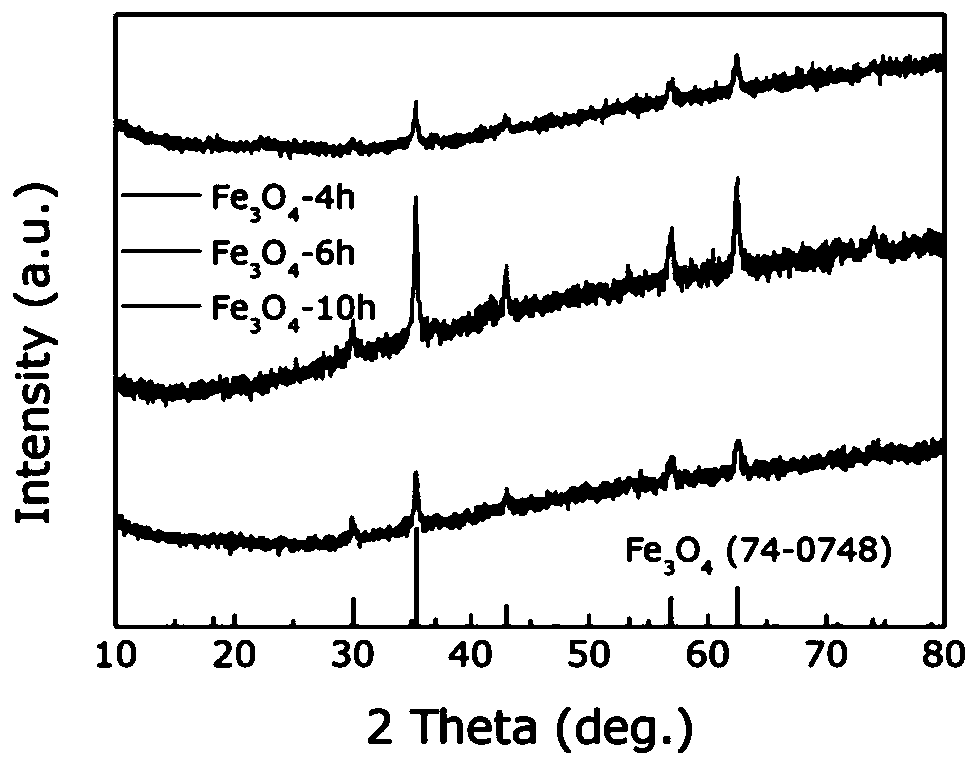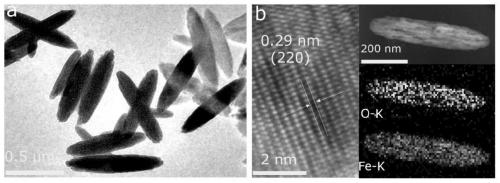Preparation method of Fe3O4 nano-rod material capable of being used for magnetic hyperthermia agents
A technology of nanorods and thermotherapy agent is applied in the biomedical application field of nanomaterials, which can solve the problems of lack of magnetothermal properties of nanorod materials, and achieve the effects of less uncontrollable factors, increased heating rate, and simple experimental operation.
- Summary
- Abstract
- Description
- Claims
- Application Information
AI Technical Summary
Problems solved by technology
Method used
Image
Examples
Embodiment 1
[0027] Weigh 1.6g FeCl 3 ·6H2 O and it was dissolved in 60mL deionized water, and the prepared solution was transferred to a high-pressure hydrothermal reactor with a volume of 100mL and sealed. Then, the reactor was placed in an oven at 100° C. for hydrothermal reaction for 4 h, and then cooled to room temperature naturally. Subsequently, the yellow precipitate obtained in the experiment was washed three times with deionized water and alcohol, centrifuged and dried at 60°C to obtain a yellow powder β-FeOOH, which we named FeOOH-4h here. Subsequently, 20 mg of β-FeOOH powder was weighed, put into 6 mL of trioctylamine, and sonicated in an ultrasonic cleaner for 2 hours to uniformly disperse them in trioctylamine. Add 200 μL of oleic acid to the suspension obtained after dispersion, stir thoroughly for 1 h, then transfer the obtained mixture to a centrifuge, and centrifuge at 7500 rpm for 5 min to obtain a gel-like mixture. Transfer the above mixture to a sealed high-temperat...
Embodiment 2
[0030] Weigh 1.6g FeCl 3 ·6H 2 O and it was dissolved in 60mL deionized water, and the prepared solution was transferred to a high-pressure hydrothermal reactor with a volume of 100mL and sealed. Then the reactor was placed in an oven at 100 °C for 10 h, and then cooled to room temperature naturally. Subsequently, the yellow precipitate obtained in the experiment was washed three times with deionized water and alcohol, centrifuged and dried at 80°C to obtain a yellow powder β-FeOOH, which we named FeOOH-10h here. Subsequently, 20 mg of β-FeOOH powder was weighed, put into 6 mL of trioctylamine, and sonicated in an ultrasonic cleaner for 2 hours to uniformly disperse them in trioctylamine. Add 200 μL of oleic acid to the suspension obtained after dispersion, stir thoroughly for 2 hours, then transfer the obtained mixture to a centrifuge, and centrifuge at 7500 rpm for 15 minutes to obtain a gel-like mixture. Transfer the above mixture to a sealed high-temperature tube furnac...
Embodiment 3
[0033] Weigh 1.6g FeCl 3 ·6H 2 O and it was dissolved in 60mL deionized water, and the prepared solution was transferred to a high-pressure hydrothermal reactor with a volume of 100mL and sealed. Then the reactor was placed in an oven at 100 °C for 6 h, and then cooled to room temperature naturally. Subsequently, the yellow precipitate obtained in the experiment was washed five times with deionized water and alcohol respectively, centrifuged and dried at 60°C to obtain a yellow powder β-FeOOH, which we named FeOOH-6h here. Subsequently, 20 mg of β-FeOOH powder was weighed, put into 6 mL of trioctylamine, and ultrasonicated for 3 h in an ultrasonic cleaner to uniformly disperse them in trioctylamine. Add 200 μL of oleic acid to the suspension obtained after dispersion, stir thoroughly for 1 h, then transfer the obtained mixture to a centrifuge, and centrifuge at 8500 rpm for 5 min to obtain a gel-like mixture. Transfer the above mixture to a sealed high-temperature tube furn...
PUM
| Property | Measurement | Unit |
|---|---|---|
| Length | aaaaa | aaaaa |
| Diameter | aaaaa | aaaaa |
| Saturation magnetization | aaaaa | aaaaa |
Abstract
Description
Claims
Application Information
 Login to View More
Login to View More - R&D Engineer
- R&D Manager
- IP Professional
- Industry Leading Data Capabilities
- Powerful AI technology
- Patent DNA Extraction
Browse by: Latest US Patents, China's latest patents, Technical Efficacy Thesaurus, Application Domain, Technology Topic, Popular Technical Reports.
© 2024 PatSnap. All rights reserved.Legal|Privacy policy|Modern Slavery Act Transparency Statement|Sitemap|About US| Contact US: help@patsnap.com










